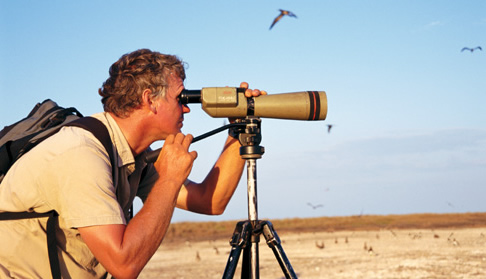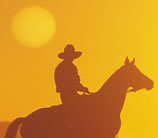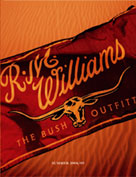ADVENTURE
Swept away by a seabird sanctuary
Story and photos Kandy Curran

There is great excitement, and a tinge of apprehension, as we zoom toward the Lacepede Islands. These far-flung islands, 150 kilometres north of Broome off the Kimberley coast, will provide fantastic bird watching opportunities with extensive colonies of breeding seabirds. We also expect to see abundant turtles, as the Lacepedes are Western Australia's largest green turtle rookery. But we can only wonder whether the dark shapes below our dinghy are marine life or the ghostly remains of pearling luggers and guano sailing ships wrecked by cyclones around the turn of last century.
Nearing the 'gut' between West and Middle Islands, the dinghies are quickly surrounded by a curious and noisy greeting party of ‘islanders'. Evidently, Homo sapiens are infrequent visitors in these parts - after all, the four flat islands that make up the group are lacking in freshwater and very windy for most of the year. Our experienced, Broome-based bird watching tour leader George Swann, who wears binoculars instead of sunglasses, excitedly reels out species names - both in the air and on the water. Juvenile Brown Boobies are the most curious birds, fanning out their tail feathers within metres of our heads for a closer look then, whoosh, they're away to catch a thermal back to the islands. The other few thousand birds adding to the cacophony of shrieks, colour and wing beats, are Brown Noddies and a pink cloud of Roseate and Bridled Terns. Meanwhile, the water looks like a frenzied torpedo attack is taking place, with green turtles making zigzagging wakes in every direction.
Before exploding out of the dinghies to explore West Island, George and Department of Conservation and Land Management (CALM) guide Tim Willing, who is a walking encyclopaedia on Kimberley flora and history, reminds the group to stay together, as access to this nature reserve is strictly controlled. There is a risk of frightening these seabirds off their nests, leaving their eggs and chicks vulnerable to attack by swooping Silver Gulls. Although our visit has been timed for least disruption of the world's largest breeding colony of Brown Boobies (estimated at 18,000 breeding pairs), there are plenty of other seabirds rising and descending from the coastal spinifex that could be nesting.
During the morning, George, whose enthusiasm for bird watching never abates, leads the group in identifying 44 species of seabirds, including two flocks of terns, and around 10,000 waders. We are also fascinated to observe at close range juvenile Lesser Frigatebirds (which look like baby vultures) and downy young Brown Boobies waiting on nests for their parents to return with a feed of regurgitated fish. On the beaches, love is in the air with green turtles mating and nesting. Indeed, the beaches look land-mined, with turtle dig-outs scattered above the high water mark.
Later that day, we visit Middle Island to gape at thousands of boobies and frigatebirds returning to their roostings. Tim guides us to the former location of the Lacepede house-come-office, jail and post office, built in 1870. Despite its stone construction, a cyclone blew it off the exposed island just10 years later. During our walk, on which we are accompanied by hundreds of low flying boobies, Tim, who is researching the history of guano mining, finds a rusty old tram wheel half buried in the sand. Between 1850 and 1870 some 37,000 tonnes of guano were mined and trammed off Middle Island to tall sailing ships bound for developing agriculture markets in Europe.
Fortunately, our waiting vessel isn't wooden, or filled with fermenting seabird droppings. Instead, the 25-metre luxury vessel ‘Kimberley Quest', to which we return after each adventure, is incredibly well equipped with nine air-conditioned cabins with ensuites and, to top it off, a helipad on the roof for a Jet Ranger. Our lusty appetites, stimulated by the wild beauty of the Kimberley environs, are satisfied by an on-board chef who impresses us with his cruise-liner style of food presentation.
Given that much of the Kimberley coast is uncharted, the vessel has plenty of navigational techno-wizardry, with dual screens in the wheelhouse and dining areas that display the route when cruising and the tides when anchored. Owner/Skipper Jeff Ralston has been cruising the Kimberley coast for 12 years and is well aware of its inherent dangers. He uses Global Positioning Satellite technology to counter the uncharted waters and, to safeguard the vessel from the world's largest tidal movements and a shifting ocean bottom, ‘Kimberley Quest' has a triple-reinforced hull.
After an overnight cruise, Adele Island is sighted, well, only just! Flat as a washed-up jellyfish, the 217 hectare sand cay is only 4m above sea level at its highest point. The marine ecology, however, is rich, with a 20km platform reef surrounding the main island and tidal estuaries draining into a central lagoon. And, with seabird droppings showering the coastal spinifex each day, there is dense cover for thousands of nesting birds, which include frigates, boobies, noddies and Bridled Terns.
It is especially fascinating watching rare birds like Red-footed Boobies courting and Greater and Lesser Frigatebirds, circling some 30m above our heads, as they wait for the right moment to rob other seabirds of their freshly-caught fish. George also teaches us how to differentiate thousands of migratory shorebirds feeding on the intertidal zone. Then, as a soupy ocean of seafood washes in with the high tide, we see the fins of reef sharks and the little heads of immature turtles coming up for a breath of fresh air. A 3m estuarine crocodile emerges briefly in a tidal creek to remind us that the 100km distance from the WA coast isn't a deterrent for a strong swimmer. Then there is the sighting of humpback whales, late on their southern migration to the Antarctica, as we head for the Walcott Inlet on the Kimberley coast.
Entering the Yule Entrance of the Walcott on an incoming tide is
an Amazonian experience, with the muddy inlet becoming a drowned valley in
a matter of hours. Turgid water that looks like it should be in a cauldron
rips around black dolerite headlands and swirls into whirlpools with a sucking
vortex powerful enough to rock the 25m vessel. With nature so wild and uninhabited,
it is easy to imagine this is a parallel universe. ![]()
Pearl Sea Coastal Cruises
Phone 61 (08) 9193 6131 fax 61 (08) 9193 6303.
email kimberleyquest@pearlseacruises.com
www.kimberleyquest.com
Kimberley Birdwatching
Phone (08) 9192 1246 fax (08) 9192 1246
email kimbird@tpg.com.au
www.kimberleybirdwatching.com.au
Full story: OUTBACK, Aug/Sept 2003


